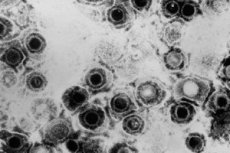Gene editing to cure herpes shows success in lab trials
Last reviewed: 14.06.2024

All iLive content is medically reviewed or fact checked to ensure as much factual accuracy as possible.
We have strict sourcing guidelines and only link to reputable media sites, academic research institutions and, whenever possible, medically peer reviewed studies. Note that the numbers in parentheses ([1], [2], etc.) are clickable links to these studies.
If you feel that any of our content is inaccurate, out-of-date, or otherwise questionable, please select it and press Ctrl + Enter.

Researchers at the Fred Hutch Cancer Center have found in preclinical studies that an experimental gene therapy for genital and oral herpes eliminates 90% or more of the infection and suppresses the amount of virus that can be shed by an infected person. This suggests that the therapy may also reduce the spread of the virus.
“Herpes is very tricky. It hides among nerve cells and then reactivates and causes painful skin blisters,” said Keith Jerome, MD, professor of vaccines and infectious diseases at the Fred Hutch Center. “Our goal is to treat people from this infection so that they do not live in constant fear of outbreaks or transmitting the virus to another person.”
Published May 13 in the journal Nature Communications, the study by Jerome and his team at the Fred Hutch Center represents an encouraging step toward gene therapy for herpes.
Experimental gene therapy involves injecting a mixture of gene-editing molecules into the blood that search for where the herpes virus is located in the body. The mixture includes laboratory-modified viruses called vectors, which are commonly used in gene therapy, and enzymes that act like molecular scissors. Once the vector reaches the clusters of nerves where the herpes virus hides, molecular scissors cut the herpes virus genes, damaging them or removing the virus completely.
“We use a meganuclease enzyme that cuts the herpes virus DNA at two different locations,” said lead author Martine Ober, Ph.D., chief scientist at the Fred Hutch Center. “These cuts damage the virus so much that it cannot recover. The body’s own repair systems then recognize the damaged DNA as foreign and get rid of it.”
Using mouse models of infection, the experimental therapy eliminated 90% of herpes simplex virus type 1 (HSV-1) after facial infection, also known as oral herpes, and 97% of HSV-1 virus after genital infection. It took about a month for the treated mice to show these reductions, and the reduction of the virus seemed to become more complete over time.
In addition, the researchers found that HSV-1 gene therapy significantly reduced both the frequency and amount of viral shedding.
Fred Hutch Center virologists Martin Ober, PhD, and Keith Jerome, MD, are conducting laboratory experiments to develop gene therapy to cure herpes. “If you talk to people living with herpes, many of them worry about whether their infection will spread to others,” Jerome said. “Our new research shows that we can reduce both the amount of virus in the body and the amount of virus shed.”
The Fred Hutch team has also simplified gene editing treatments, making them safer and easier to manufacture. In the 2020 study, they used three vectors and two different meganucleases. The latest study uses just one vector and one meganuclease, which can cut the viral DNA in two places.
“Our simplified gene editing approach is effective in eliminating the herpes virus and has fewer side effects on the liver and nerves,” Jerome said. "This suggests the therapy will be safer for people and easier to produce because it contains fewer components."
While scientists at the Fred Hutch Center are encouraged by how well gene therapy works in animal models and are eager to translate their findings into human treatments, they are also cautious about the steps needed to prepare for clinical trials. They also noted that while the current study looked at HSV-1 infections, they are working on adapting gene editing technology to target HSV-2 infections.
“We are collaborating with many partners as we move toward clinical trials to meet federal regulatory requirements to ensure gene therapy is safe and effective,” Jerome said. “We deeply appreciate the support of herpes cure advocates who share our vision of curing this infection.”
Herpes simplex virus (HSV) is a common infection that lasts a lifetime once infected. Current therapies can only suppress symptoms but not completely eliminate them, which include painful blisters. According to the World Health Organization, about 3.7 billion people under the age of 50 (67%) have HSV-1, which causes oral herpes. About 491 million people aged 15-49 years (13%) worldwide have HSV-2, which causes genital herpes.
Herpes can also cause other harm to people's health. HSV-2 increases the risk of contracting HIV. Other studies have linked dementia to HSV-1.
